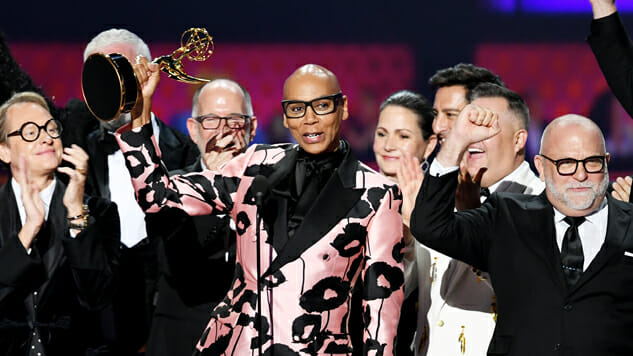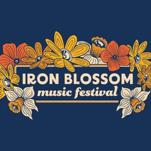So RuPaul’s Hosting SNL: What Does “Mainstream” Mean for Drag?
Photo by Kevin Winter/Getty
Well guys, it’s happening. RuPaul is hosting Saturday Night Live for the very first time this Saturday, Feb. 8. Among fans of his now seminal competition show RuPaul’s Drag Race, there seems to be a certain… lack of surprise. Where some of us might be delighted for this to have happened 10 (or even 20) years ago, it now raises some questions about what drag means today, and what the national context of “TV drag” is.
RuPaul’s Drag Race was not an overnight success. In fact, its first season, which aired in 2009, was for some years impossible to find. Later, in 2013, Logo would go on to re-air the rebrand it as “The Lost Season,” featuring commentary from RuPaul himself. Looking back at it now is almost like looking at records from a forgotten age—the production value is abysmally poor, and while the cash prize of $20,000 is nothing to sneeze at, it pales in comparison to the current typical rate of $100,000 per win.
Did any of those queens from 2009 expect Drag Race—or, more broadly, the art of drag—to be where it is today? Back in 2017, former contestant Adore Delano set a benchmark milestone: she became the first Drag Race alum to reach a million followers on Instagram. What does this mean for her drag? In some ways, it points to accessibility—something about her drag was appealing, and it managed to attract a huge audience.
But here’s the thing: does that make it mainstream? Does accessibility and popular appeal necessarily equate to operating within a larger, more global system like that? Honestly, it’s hard to say. What we do know is that Drag Race’s 9th season, its first to air on the coveted Friday slot on their new network (VH1), premiered with a viewership just shy of 1 million viewers. But Lady Gaga was a guest star for the episode, and, obviously, her appearance was heavily promoted. In some ways, there’s precedence for drag being acknowledged at that major level, although only if it is somehow associated with aspects of major culture.
Just this week, The Good Place star Jameela Jamil was announced as a judge for Legendary, an upcoming HBO Max voguing competition show. The amount of backlash she received was enormous, prompting her announcement of her queerness via Twitter. Heidi Klum recently faced similar backlash for her new hosting gig on Queen of Drags, a German drag competition show (alongside judges Conchita Wurst from Eurovision and Bill Kaulitz from Tokio Hotel, remember them?) Who do we want to host these shows? Or should they not be on TV at all? In Jamil’s Twitter message, she notes “I know that my being queer doesn’t qualify me as ballroom. But I have privilege and power and a large following to bring to this show…” The unfortunate truth is, without these celebrities’ support, we might not have a show about voguing. Are we okay with that?
On another level, though, what do fandom and popularity mean for drag queens, an occupation for some of the world’s most traditionally invisible minorities? Well, for one, it means more money. Think of it this way—it costs to be a drag queen. Makeup, wigs, and costumes are expensive, and if you want to keep it fresh and surprising, these things have to be updated periodically. In a feature by VICE from 2018, professional queen Gina Tonic says “It’s definitely a sustainable long-term career, as long as you are smart about it and find ways to stand out and stay relevant.” This relevance can mean a lot of things: a social media following, TV appearances, extensive and appealing merchandise, constant shows, or a supplementary, more “mainstream” job to allow for a hobby to turn into a dream. (However it is worth noting that, as of today, 27 former Drag Race queens have over 1 million Instagram followers, with only three of those queens being black.)
Sometimes Drag Race makes me realize other things about the world. NOT ALL, but a lot of the most popular queens fall into the thin white category. And NO black queens, except @RuPaul, have over a million followers. It’s not the show. It’s the fandom. pic.twitter.com/ngevUfrSfU
— Bob The Drag Queen (@thatonequeen) June 15, 2018
This is the simple fact: No one should be robbing any queer artist of an opportunity to make money. Your average drag queen is not an on-screen star, and even those who are aren’t necessarily making six-figures right off their tenure on Drag Race. No, they’re paying money to make gigs happen, still performing in the same clubs and venues once they make it home.
But look, RuPaul Charles is not your average drag queen sustaining herself off t-shirt sales and tips shoved into her bra. RuPaul is a certified superstar, and for nearly every queer artist working today, one of the first visibly in-your-face, on-screen performers of his caliber. Hell, he even started his own convention, DragCon, which in 2018 had over 50,000 attendees.
So doesn’t it seem a little late for RuPaul to be a guest on Saturday Night Live now of all times? It seems like a perfect fit—SNL cast members have been appearing as guest judges on the show since Rachel Dratch’s appearance on All Stars 1, being followed by Cecily Strong and Bobby Moynihan. There’s probably a really simple answer for this: Homophobia. Look no further than the one appearance RuPaul has made on SNL—in 1993, he appeared on SNL’s Season 19 premiere alongside host Charles Barkley in a skit titled “What’s That?” in which game show contestants attempt to guess the sex of appearing people.
-

-

-

-

-

-

-

-

-

-

-

-

-

-

-

-

-

-

-

-

-

-

-

-

-

-

-

-

-

-

-

-

-

-

-

-

-

-

-

-








































